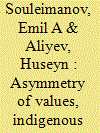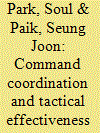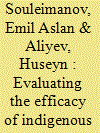| Srl | Item |
| 1 |
ID:
142646


|
|
|
|
|
| Summary/Abstract |
This article fills the gap in existing scholarship on asymmetric conflict, indigenous forces, and how socio-cultural codes shape the dynamics and outcomes of conflict transformation. Specifically, it identifies three key socio-cultural values commonplace in honorific societies: retaliation, hospitality, and silence. As sources of effective pro-insurgent violent mobilisation and support from among the local population, these values provide insurgents with an asymmetric advantage over much stronger incumbents. Using the case studies of the two Russian counterinsurgencies in Chechnya, the article shows the mechanisms on the ground through which Moscow’s deployment of indigenous forces against insurgents helped to stem the tide of conflict, reversing the insurgents’ initial advantage in terms of asymmetry of values.
|
|
|
|
|
|
|
|
|
|
|
|
|
|
|
|
| 2 |
ID:
158978


|
|
|
|
|
| Summary/Abstract |
This article analyzes the causes of combat effectiveness of the South Korean security forces through the course of its various counter-insurgency (COIN) operations from 1948 to 1953. We argue that improvements in two interrelated aspects ultimately resulted in higher operational and tactical level performance: unified operational command structure and the subsequent improvements in tactical efficiency under the guidance of the US advisory mission. Through an in-depth case study on how a nascent army improved its capacity in combating homegrown insurgencies, we demonstrate how the actual conduct of operations itself remains just as significant in the assessment of overall COIN outcomes.
|
|
|
|
|
|
|
|
|
|
|
|
|
|
|
|
| 3 |
ID:
144773


|
|
|
|
|
| Summary/Abstract |
This study seeks to identify factors conducive to the (in)efficacy of indigenous forces (IF) in counterinsurgency (COIN) operations in Russia’s republics of Chechnya and Dagestan. Empirically, it is the first study to offer an examination of the deployment of IF in the North Caucasus-based COIN. The findings of this article emphasize that the effectiveness of COIN in Chechnya, unlike Dagestan, is conditioned by a number of factors pertaining to the structural and organizational characteristics of IF. Of these, the IF’s experience as former insurgents, their access to insider information, and their loyalty to incumbents – often maintained by the threat of collective punishment – have proven decisive for a relatively successful COIN in Chechnya.
|
|
|
|
|
|
|
|
|
|
|
|
|
|
|
|
| 4 |
ID:
087825


|
|
|
|
|
| Publication |
2009.
|
| Summary/Abstract |
While the importance of indigenous forces for successful counterinsurgency operations has long been recognized by great powers fighting local insurgencies, the factors that determine the performance of such forces have attracted relatively little scholarly attention. This paper aims to contribute to our understanding of those determinants through an examination of the role and performance of auxiliary indigenous units in French counterinsurgency operations during the Algerian War (1954-62). The findings presented here suggest some important lessons for those seeking to recruit and deploy effective indigenous forces in counterinsurgency operations.
|
|
|
|
|
|
|
|
|
|
|
|
|
|
|
|